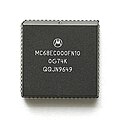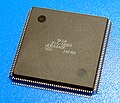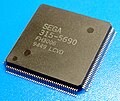Sega Saturn
|
Western and Eastern Sega Saturn logos | |
|
Top: Model 1 of North America Bottom: Model 2 of Japan | |
| Manufacturer | Sega |
|---|---|
| Type | Home video game console |
| Generation | Fifth generation |
| Release date |
JP: November 22, 1994 NA: May 11, 1995 EU: July 8, 1995 |
| Retail availability | 1994-2000 |
| Introductory price |
JP: ¥44,800 US: US$399 UK: ₤399.99 |
| Discontinued |
EU: 1998 NA: 1998 JP: 2000 |
| Units sold | 9.26 million |
| Media | CD-ROM, CD+G, CD+EG, Video CD, Mini CD, Photo CD, E-book |
| CPU | 2× Hitachi SH-2 @ 28.6 MHz |
| Storage | Internal RAM, cartridge |
| Graphics | VDP1 & VDP2 video display processors |
| Sound | Yamaha YMF292 |
| Online services | Sega NetLink |
| Predecessor | Sega Genesis |
| Successor | Dreamcast |
Introduction[edit]
The Sega Saturn is a 32-bit fifth-generation home video game console developed by Sega and released on November 22, 1994 in Japan, May 11, 1995 in North America, and July 8, 1995 in Europe. The successor to the successful Sega Genesis, the Saturn has a dual-CPU architecture and eight processors. Its games are in CD-ROM format, and its game library contains several arcade ports as well as original games.
Development of the Saturn began in 1992, the same year Sega's groundbreaking 3D Model 1 arcade hardware debuted. Designed around a new CPU from Japanese electronics company Hitachi, another video display processor was incorporated into the system's design in early 1994 to better compete with Sony's forthcoming PlayStation.
The Saturn was initially successful in Japan, but failed to sell in large numbers in the United States after its surprise May 1995 launch, four months before its scheduled release date. After the debut of the Nintendo 64 in late 1996, the Saturn rapidly lost market share in the U.S., where it was discontinued in 1998. Having sold 9.26 million units worldwide, the Saturn is considered a commercial failure. The failure of Sega's development teams to release a game in the Sonic the Hedgehog series, known in development as Sonic X-treme, has been considered a factor in the console's poor performance.
Although the Saturn is remembered for several well-regarded games, including Nights into Dreams, the Panzer Dragoon series, and the Virtua Fighter series, its reputation is mixed due to its complex hardware design and limited third-party support. Sega's management has been criticized for its decisions during the system's development and discontinuation.
Specifications[edit]
Featuring a total of eight processors the Saturn's main central processing units are two Hitachi SH-2 microprocessors clocked at 28.6 MHz and capable of 56 MIPS. The system contains a Motorola 68EC000 running at 11.3 MHz as a sound controller, a custom sound processor with an integrated Yamaha FH1 DSP running at 22.6 MHz capable of up to 32 sound channels with both FM synthesis and 16-bit PCM sampling at a maximum rate of 44.1 kHz, and two video display processors, the VDP1 (which handles sprites, textures and polygons) and the VDP2 (which handles backgrounds). Its double-speed CD-ROM drive is controlled by a dedicated Hitachi SH-1 processor to reduce load times. The Saturn's System Control Unit (SCU), which controls all buses and functions as a co-processor of the main SH-2 CPU, has an internal DSP running at 14.3 MHz. The Saturn contains a cartridge slot for memory expansion, 16 Mbit of work random-access memory (RAM), 12 Mbit of video RAM, 4 Mbit of RAM for sound functions, 4 Mbit of CD buffer RAM and 256 Kbit (32 KB) of battery backup RAM. Its video output, provided by a stereo AV cable, displays at resolutions from 320×224 to 704×224 pixels, and is capable of displaying up to 16.77 million colors simultaneously. Physically, the Saturn measures 260 mm × 230 mm × 83 mm (10.2 in × 9.1 in × 3.3 in). The Saturn was sold packaged with an instruction manual, one control pad, a stereo AV cable, and its 100V AC power supply, with a power consumption of approximately 15W.
- "One very fast central processor would be preferable. I don't think all programmers have the ability to program two CPUs—most can only get about one-and-a-half times the speed you can get from one SH-2. I think that only 1 in 100 programmers are good enough to get this kind of speed [nearly double] out of the Saturn."
Yu Suzuki reflecting upon Saturn Virtua Fighter development.
The Saturn had technically impressive hardware at the time of its release, but its complexity made harnessing this power difficult for developers accustomed to conventional programming. The greatest disadvantage was that both CPUs shared the same bus and were unable to access system memory at the same time. Making full use of the 4 kB of cache memory in each CPU was critical to maintaining performance. For example, Virtua Fighter used one CPU for each character, while Nights used one CPU for 3D environments and the other for 2D objects. The Saturn's Visual Display Processor 2 (VDP2), which can generate and manipulate backgrounds, has also been cited as one of the system's most important features.
The Saturn's design elicited mixed commentary among game developers and journalists. Developers quoted by Next Generation in December 1995 described the Saturn as "a real coder's machine" for "those who love to get their teeth into assembly and really hack the hardware", with "more flexibility" and "more calculating power than the PlayStation". The Saturn's sound board was also widely praised. By contrast, Lobotomy Software programmer Ezra Dreisbach described the Saturn as significantly slower than the PlayStation, whereas Kenji Eno of WARP observed little difference between the two systems. In particular, Dreisbach criticized the Saturn's use of quadrilaterals as its basic geometric primitive, in contrast to the triangles rendered by the PlayStation and the Nintendo 64. Ken Humphries of Time Warner Interactive remarked that compared to the PlayStation, the Saturn was markedly worse at generating polygons but markedly better at sprite-based graphics. Third-party development was initially hindered by the lack of useful software libraries and development tools, requiring developers to write in assembly language to achieve good performance. During early Saturn development, programming in assembly could offer a two-to-fivefold speed increase over higher-level languages like C. The Saturn hardware is considered extremely difficult to emulate. Sega responded to complaints about the difficulty of programming for the Saturn by writing new graphics libraries which were claimed to make development easier. Sega of America also purchased a United Kingdom-based development firm, Cross Products, to produce the Saturn's official development system. Despite these challenges, Treasure CEO Masato Maegawa stated that the Nintendo 64 was more difficult to develop for than the Saturn. Traveller's Tales' Jon Burton opined that while the PlayStation was easier "to get started on ... you quickly reach [its] limits", whereas the Saturn's "complicated" hardware had the ability to "improve the speed and look of a game when all used together correctly." A major point of criticism was the Saturn's use of 2D sprites to generate polygons and simulate 3D space. The PlayStation functioned in a similar manner, but also featured a dedicated "Geometry Transfer Engine" that rendered additional polygons. As a result, several analysts described the Saturn as an "essentially" 2D system.
Several models of the Saturn were produced in Japan. An updated model in a recolored light gray (officially white) was released in Japan at a price of ¥20,000 in order to reduce the system's cost and raise its appeal among women and younger children. Two models were released by third parties: Hitachi released a model known as the Hi-Saturn (a smaller Saturn model equipped with a car navigation function), while JVC released the V-Saturn. Saturn controllers came in various color schemes to match different models of the console. The system also supports several accessories. A wireless controller powered by AA batteries utilizes infrared signal to connect to the Saturn. Designed to work with Nights, the Saturn 3D Pad includes both a control pad and an analog stick for directional input. Sega also released several versions of arcade sticks as peripherals, including the Virtua Stick, the Virtua Stick Pro, the Mission Analog Stick, and the Twin Stick. Sega also created a light gun peripheral known as the "Virtua Gun" for use with shooting games such as Virtua Cop and The Guardian, as well as the Arcade Racer, a wheel for racing games. The Play Cable allows for two Saturn consoles to be connected for multiplayer gaming across two screens, while a multitap allows up to six players to play games on the same console. The Saturn was designed to support up to 12 players on a single console, by using two multitaps. RAM cartridges expand the amount of memory in the system. Other accessories include a keyboard, mouse, floppy disk drive, and movie card.
Like the Genesis, the Saturn had an Internet-based gaming service. The Sega NetLink was a 28.8k modem that fit into the cartridge slot in the Saturn for direct dial multiplayer. In Japan, a now defunct pay-to-play service was used. It could also be used for web browsing, sending email, and online chat. Because the NetLink was released before the Saturn keyboard, Sega produced a series of CDs containing hundreds of website addresses so that Saturn owners could browse with the joypad. The NetLink functioned with five games: Daytona USA, Duke Nukem 3D, Saturn Bomberman, Sega Rally, and Virtual On: Cyber Troopers. In 1995 Sega announced it was developing a variant of the Saturn featuring a built-in NetLink modem under the code name "Sega Pluto", but it was never released.
Sega developed an arcade board based on the Saturn's hardware, called the Sega ST-V (or Titan), which was intended as an affordable alternative to Sega's Model 2 arcade board as well as a testing ground for upcoming Saturn software. The Titan was criticized for its comparatively weak performance by Sega AM2's Yu Suzuki and was overproduced by Sega's arcade division. Because Sega already possessed the Die Hard license, members of Sega AM1 working at the Sega Technical Institute developed Die Hard Arcade for the Titan to clear out excess inventory. Die Hard became the most successful Sega arcade game produced in the United States at that point. Other games released for the Titan include Golden Axe: The Duel and Virtua Fighter Kids.













